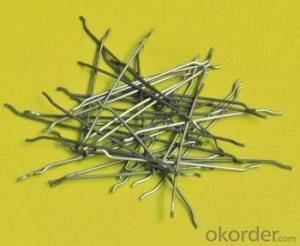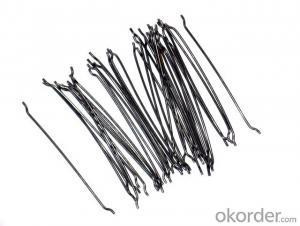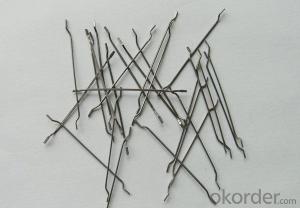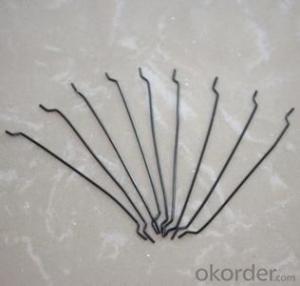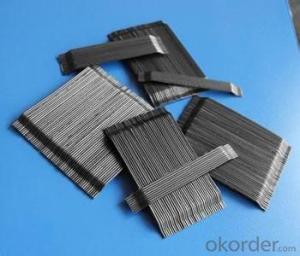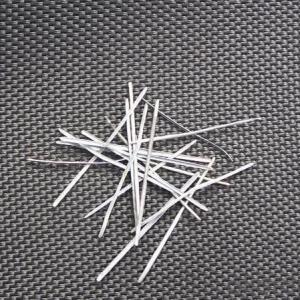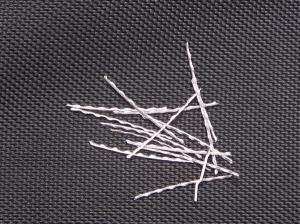Melt Extract Stainless Steel Fiber Concrete Steel Fiber 0.75/50 from CNBM China
- Loading Port:
- Tianjin
- Payment Terms:
- TT OR LC
- Min Order Qty:
- 1 m.t.
- Supply Capability:
- 5000 m.t./month
OKorder Service Pledge
Quality Product, Order Online Tracking, Timely Delivery
OKorder Financial Service
Credit Rating, Credit Services, Credit Purchasing
You Might Also Like
Quick Details
Place of Origin: Tianjin, China (Mainland)
Model Number: 0.75
Material: Steel
Production Process: Cold drawn
Lengh: 50
Type: 1
Compressive Strength: >1200MPa
Aspect ratio: 66
Standard: ASTM A820M-11
Section Shape: Circular
Application: Concrete Reinforcement
Packaging & Delivery
| Packaging Details: | 20 kg/Bag,50 bags/Pallet or 1,000kg/ Bulk Bag |
|---|---|
| Delivery Detail: | 1 Month |
Product Description
| Diameter | 0.75 | mm | 0.03 | in |
| Length | 50.00 | mm | 1.96 | in |
| Aspect Ratio | 67 | |||
| Tensile strength | 1200 MPa | |||
| Type | Cold drawn Steel Fiber | |||
| End | Hooked-end Steel Fiber | |||
| Glued/Loose | Glued Steel Fiber | |||
| Bending Angle | 45°(min.30°) | |||
| Usage & Performance | Floor:Trafficked areas and Industrial floors | |||
| Shotcrete :Slope stabilization and Final lining | ||||
| Precast concrete:Pipe and Railway sleepers | ||||
| Packing | Standard Export Pallet Packing | Bag Packing | 20 kg/Bag,50 bags/Pallet | |
| Bulk Packing | 1,000kg/ Bulk Bag | |||
| Loading Quantity | 20’GP | 20-25 Tonne/Tonnes | ||
| 40’GP | 25-27 Tonne/Tonnes | |||
| 40’HQ | 25-27 Tonne/Tonnes | |||
| MOQ | 1 kg for trial order | |||
| Supply Ability | 10,000 Tonne/Tonnes per Year | |||
| Payment Terms | T/T or L/C at sight | |||
| Delivery Time | Within 15 days after receiving deposit or original L/C at sight | |||
| Certification | ISO9001:2000, CE, | |||

| Product | Diameter | Length mm/in | Aspect Ratio | Type | Packing |
| G-6030 | 0.5 mm (0.0197 in) | 30 mm (1.1811 in) | 60 | Glued | 20 kg/Bag, or 1,000kg/ Bulk Bag |
| G-6535 | 0.55 mm (0.0217 in) | 35 mm (1.3780 in) | 65 | Glued | 20 kg/Bag, or 1,000kg/ Bulk Bag |
| G-6035 | 0.6 mm (0.0236 in) | 35 mm (1.3780 in) | 60 | Glued | 20 kg/Bag, or 1,000kg/ Bulk Bag |
| G-8060 | 0.75 mm (0.0295 in) | 60 mm (2.3622 in) | 80 | Glued | 20 kg/Bag, 50 bags/Pallet |
| G-6060 | 0.9 mm (0.0354 in) | 60 mm (2.3622 in) | 60 | Glued | 20 kg/Bag, 50 bags/Pallet |
| G-6030 | 0.5 mm (0.0197 in) | 30 mm (1.1811 in) | 60 | Loose | 20 kg/Bag, or 1,000kg/ Bulk Bag |
| G-6535 | 0.55 mm (0.0217 in) | 35 mm (1.3780 in) | 65 | Loose | 20 kg/Bag, or 1,000kg/ Bulk Bag |
| G-6035 | 0.6 mm (0.0236 in) | 35 mm (1.3780 in) | 60 | Loose | 20 kg/Bag, or 1,000kg/ Bulk Bag |
| G-8060 | 0.75 mm (0.0295 in) | 60 mm (2.3622 in) | 80 | Loose | 20 kg/Bag, 50 bags/Pallet |
| G-6060 | 0.9 mm (0.0354 in) | 60 mm (2.3622 in) | 60 | Loose | 20 kg/Bag, 50 bags/Pallet |
- Q: Can melt extract stainless steel fiber be used in sports field pavements?
- Sports field pavements can indeed utilize melt extract stainless steel fiber. With their remarkable strength and durability, stainless steel fibers are an ideal option for endeavors necessitating resistance to wear and heavy traffic, such as sports field pavements. By augmenting toughness, crack resistance, and fatigue resistance, these fibers ameliorate the overall performance and lifespan of the pavement. Moreover, the corrosion resistance of stainless steel ensures that the fibers remain intact in adverse weather conditions, guaranteeing their long-term viability. All in all, incorporating melt extract stainless steel fiber into sports field pavements generates a sturdier, more enduring surface capable of withstanding the rigorous demands of athletic activities.
- Q: How does melt extract stainless steel fiber improve the impact resistance of concrete pavers?
- Melt extract stainless steel fiber improves the impact resistance of concrete pavers by reinforcing the concrete matrix. The fibers are evenly distributed throughout the concrete mixture, creating a three-dimensional network that enhances the overall structural integrity of the pavers. This reinforcement helps to absorb and distribute the impact energy, making the pavers more resistant to cracking, spalling, and other forms of damage caused by impact or heavy loads.
- Q: How does melt extract stainless steel fiber enhance the impact resistance of concrete?
- Melt extract stainless steel fiber enhances the impact resistance of concrete through several mechanisms. Firstly, the addition of stainless steel fibers in concrete increases its tensile strength, resulting in improved resistance to cracking and spalling upon impact. These fibers act as reinforcement, distributing the load more evenly throughout the concrete matrix, thus reducing the concentration of stress at any particular point. Furthermore, the high aspect ratio of stainless steel fibers allows them to bridge across cracks that may occur under impact, effectively inhibiting their propagation. This bridging effect not only enhances the overall structural integrity of the concrete but also prevents the development of larger cracks that could compromise its impact resistance. Additionally, the unique properties of stainless steel, such as its high strength and corrosion resistance, make it an ideal material for enhancing the impact resistance of concrete. Stainless steel fibers are highly durable and can withstand the harsh conditions often encountered in concrete structures, including exposure to chemicals, moisture, and temperature variations. Moreover, the random distribution of stainless steel fibers within the concrete mix creates a three-dimensional reinforcement network, which helps to absorb and dissipate energy upon impact. This energy absorption capability reduces the force transmitted through the concrete, minimizing the risk of damage or failure under impact loadings. Overall, the incorporation of melt extract stainless steel fiber in concrete significantly enhances its impact resistance by improving its tensile strength, inhibiting crack propagation, providing durability, and absorbing energy. This reinforcement technique is particularly beneficial in applications where concrete structures are subjected to frequent impact or dynamic loads, such as industrial floors, pavements, bridge decks, and blast-resistant structures.
- Q: How does melt extract stainless steel fiber improve the toughness of high-performance concrete?
- Melt extract stainless steel fiber improves the toughness of high-performance concrete through several key mechanisms. Firstly, the addition of stainless steel fibers enhances the crack resistance of the concrete. When the concrete is subjected to stress or loading, the fibers act as reinforcement and help to prevent the propagation of cracks. This results in a more durable and resilient material that can withstand higher levels of stress without significant damage. Secondly, the stainless steel fibers also improve the post-crack behavior of the concrete. Once cracks start to develop, the fibers distribute the stress more evenly throughout the material, effectively dissipating the energy and preventing further crack growth. This ensures that the concrete maintains its structural integrity even after the initiation of cracks, thereby enhancing its overall toughness. Furthermore, the addition of melt extract stainless steel fibers can also enhance the flexural strength of high-performance concrete. The fibers act as reinforcement within the matrix, increasing the tensile strength and preventing the concrete from undergoing excessive deflection or failure under bending loads. This is particularly important in applications where high-performance concrete is exposed to dynamic or impact loading. Moreover, the stainless steel fibers also improve the resistance of high-performance concrete to shrinkage and thermal cracking. Due to their high melting point and low coefficient of thermal expansion, these fibers provide enhanced dimensional stability to the concrete, reducing the risk of cracking caused by temperature variations or drying shrinkage. In summary, melt extract stainless steel fiber improves the toughness of high-performance concrete by enhancing crack resistance, improving post-crack behavior, increasing flexural strength, and reducing the risk of shrinkage and thermal cracking. These properties make high-performance concrete with stainless steel fibers an ideal choice for structures that require durability, resistance to cracking, and the ability to withstand high levels of stress and loading.
- Q: How does melt extract stainless steel fiber improve the fire resistance of shotcrete?
- Melt extract stainless steel fiber improves the fire resistance of shotcrete by providing enhanced structural integrity and heat resistance. The fibers act as reinforcement, reducing cracking and spalling during high temperatures. This helps to maintain the structural stability of the shotcrete, preventing it from collapsing or disintegrating under fire conditions. Additionally, the stainless steel fibers create a barrier that slows down heat transfer, reducing the spread of fire within the shotcrete. Overall, the inclusion of melt extract stainless steel fiber significantly enhances the fire resistance of shotcrete, making it a more reliable and durable material for fire protection applications.
- Q: What is the effect of melt extract stainless steel fiber on the permeability of shotcrete?
- The effect of melt extract stainless steel fiber on the permeability of shotcrete is to significantly reduce or eliminate the permeability altogether. Shotcrete is a construction material that is commonly used for applications such as tunnel linings, retaining walls, and slope stabilization. Permeability refers to the ability of a material to allow the passage of fluids or gases through its pores or cracks. When melt extract stainless steel fibers are added to shotcrete, they create a dense network within the material. This network acts as reinforcement and helps to improve the overall strength and durability of the shotcrete. Additionally, the stainless steel fibers fill any voids or cracks in the shotcrete, reducing its permeability and preventing the ingress of water, gases, or other substances. The melt extract stainless steel fibers also enhance the cohesion and bonding of the shotcrete, improving its resistance to cracking and spalling. This is particularly beneficial in applications where the shotcrete is exposed to harsh environmental conditions or high levels of moisture. Overall, the addition of melt extract stainless steel fibers to shotcrete has a positive effect on its permeability, making it a more reliable and durable construction material. This improvement in permeability helps to enhance the performance and lifespan of shotcrete structures, ensuring their long-term integrity and functionality.
- Q: How does melt extract stainless steel fiber improve the ductility of concrete?
- Melt extract stainless steel fiber improves the ductility of concrete through its unique properties and behavior when added to the concrete mix. Stainless steel fiber is known for its high tensile strength and excellent resistance to corrosion and fatigue. When added to concrete, it forms a three-dimensional reinforcement network that enhances the overall ductility of the material. The presence of stainless steel fibers in concrete helps to distribute and dissipate stresses more evenly throughout the structure. This reduces the concentration of stress at specific points and increases the overall resistance to cracking and failure. By bridging the cracks that may form in the concrete, stainless steel fibers prevent the propagation of cracks, making the material more ductile. Moreover, the high tensile strength of stainless steel fibers allows them to carry significant loads even after the concrete matrix starts to crack. This additional load-carrying capacity helps to delay the onset of failure and provides a safety margin for the structure. By enhancing the structural integrity, stainless steel fibers improve the overall ductility of concrete. Additionally, stainless steel fibers also improve the post-cracking behavior of concrete. When cracks do occur, the fibers act as reinforcement and help to maintain the integrity of the structure. They prevent the cracks from widening and spreading, which in turn preserves the load-carrying capacity of the concrete. This post-cracking behavior further enhances the ductility of the material. In summary, melt extract stainless steel fiber improves the ductility of concrete by forming a three-dimensional reinforcement network, distributing stresses more evenly, preventing crack propagation, enhancing load-carrying capacity, and improving post-cracking behavior. These properties make stainless steel fiber an effective addition to concrete mixes, particularly in applications where enhanced durability and resilience are desired.
- Q: How does melt extract stainless steel fiber improve the bond strength of shotcrete?
- Shotcrete bond strength is improved in multiple ways by melt extract stainless steel fiber. Firstly, the reinforcement provided by the steel fibers within the shotcrete mix increases the material's strength. The fibers are evenly distributed throughout the mix when applied, creating a reinforcement network that enhances overall bond strength. Secondly, the high aspect ratio of the stainless steel fibers, characterized by their length and thinness, allows them to effectively bridge any cracks or voids that may form within the shotcrete. By bridging these gaps, the fibers prevent crack propagation and enhance material cohesion, thereby increasing bond strength. Moreover, the stainless steel fibers also enhance shotcrete durability. With corrosion resistance properties, they can withstand harsh environments and prevent degradation over time. This durability ensures that the bond strength of the shotcrete remains intact for an extended period, even under challenging conditions. In conclusion, melt extract stainless steel fiber improves shotcrete bond strength through reinforcement, crack bridging, and increased durability. This makes shotcrete more reliable and effective for various construction applications, including tunnel linings, retaining walls, and structural repairs.
- Q: Can melt extract stainless steel fiber be used in lightweight concrete blocks or panels?
- Yes, melt extract stainless steel fiber can be used in lightweight concrete blocks or panels. Lightweight concrete blocks or panels are typically made by using lightweight aggregates and reducing the density of the concrete mixture. The addition of stainless steel fibers can enhance the mechanical properties of the lightweight concrete, such as increasing tensile and flexural strength, reducing cracking, and improving the overall durability of the blocks or panels. Stainless steel fibers have high tensile strength, corrosion resistance, and excellent bonding properties with concrete, making them ideal for reinforcing lightweight concrete structures. Additionally, the use of stainless steel fibers can also provide improved resistance to fire, impact, and fatigue. Therefore, melt extract stainless steel fiber is a suitable reinforcement option for lightweight concrete blocks or panels.
- Q: How does melt extract stainless steel fiber affect the abrasion resistance of concrete?
- Melt extract stainless steel fiber significantly improves the abrasion resistance of concrete. The addition of these fibers enhances the overall durability and toughness of the concrete, making it more resistant to wear and tear caused by abrasion. The fibers reinforce the concrete matrix, thereby reducing the formation of cracks and increasing its resistance to surface abrasion.
Send your message to us
Melt Extract Stainless Steel Fiber Concrete Steel Fiber 0.75/50 from CNBM China
- Loading Port:
- Tianjin
- Payment Terms:
- TT OR LC
- Min Order Qty:
- 1 m.t.
- Supply Capability:
- 5000 m.t./month
OKorder Service Pledge
Quality Product, Order Online Tracking, Timely Delivery
OKorder Financial Service
Credit Rating, Credit Services, Credit Purchasing
Similar products
Hot products
Hot Searches
Related keywords







